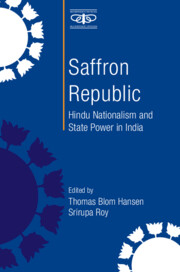13 - Pratikriya, Guilt, and Reactionary Violence
Published online by Cambridge University Press: 31 May 2022
Summary
In late February and early March 2002, the city of Ahmedabad in Gujarat descended into a pogrom. Hindu activists were returning from the temple town of Ayodhya, a popular pilgrimage site outside the state, in an overcrowded train. They had gone there to support the building of a Hindu temple to Lord Ram on the site of a former Muslim mosque, which had been destroyed by activists ten years earlier. The train stopped briefly in Godhra. After an altercation between Muslim station vendors and Hindu activists, stones were thrown onto the train, which stopped again outside the station. Then two coaches of the train caught fire. Many passengers were killed. In the days and weeks following the incident, the Muslim community of Gujarat became the target of a state-wide pogrom. In cities like Ahmedabad, Muslims faced economic boycotts, attacks on their residential neighbourhoods, destruction of their property, and the indifference or complicity of the police in these acts. Hundreds of Muslim shrines and mosques were attacked, burnt, and razed to the ground. Mass rape, arson, and deadly violent attacks by large, organized crowds and gangs armed with swords took place in front of a gaping, knowing, and partly approving or even participating public.
This event is commonly referred to as the ‘Gujarat riots’. The passage from pogrom to riot constitutes an act of reduction that does two things at once. It integrates a particular event into a series of preceding events, eliminating its specificity. Furthermore, the term ‘riot’ complicates the assertion of culpability because it invokes two equal communities mutually attacking one another. Pogroms, by contrast, are organized events following a planned objective characterized by a psychological mobilization that far exceeds the immediate group of actors in a riot. There is no concept in Gujarati that can be assimilated semantically to the term pogrom, though there are many words that allow for the rendering of riot (Ghassem-Fachandi 2012, 60).
When the state had barely begun recovering in May, Uma Bharati, the then Union Minister for Youth and Sports, responded to a query by a journalist why the ‘riots’ had been so exceptional.
- Type
- Chapter
- Information
- Saffron RepublicHindu Nationalism and State Power in India, pp. 284 - 305Publisher: Cambridge University PressPrint publication year: 2022

